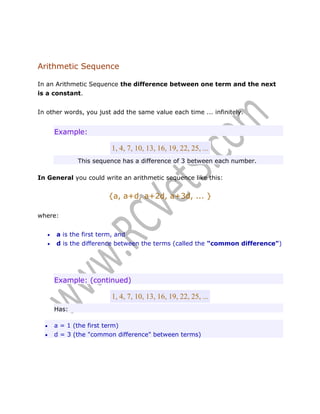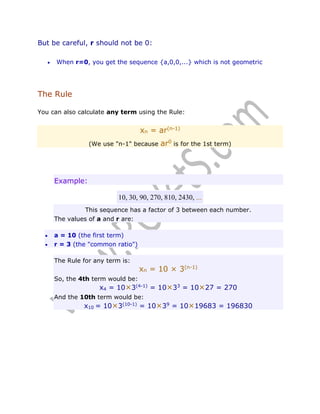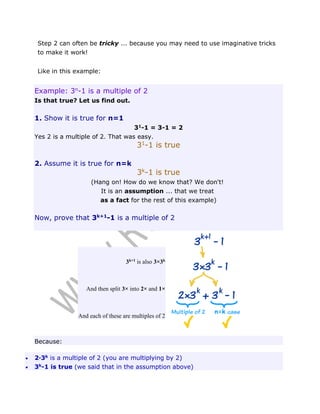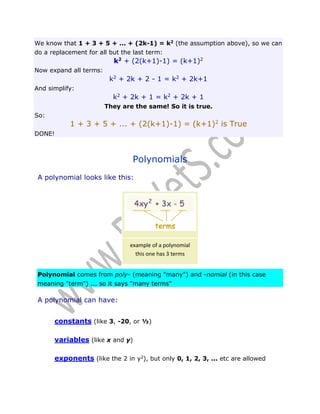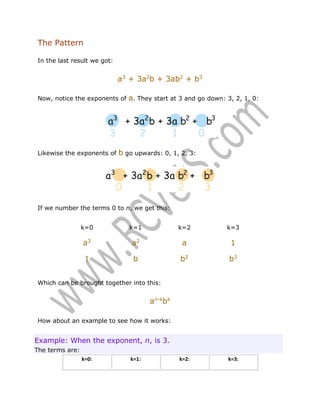Math lecture 7 (Arithmetic Sequence)
- 1. Arithmetic Sequence In an Arithmetic Sequence the difference between one term and the next is a constant. In other words, you just add the same value each time ... infinitely. Example: 1, 4, 7, 10, 13, 16, 19, 22, 25, ... This sequence has a difference of 3 between each number. In General you could write an arithmetic sequence like this: {a, a+d, a+2d, a+3d, ... } where: a is the first term, and d is the difference between the terms (called the "common difference") Example: (continued) 1, 4, 7, 10, 13, 16, 19, 22, 25, ... Has: a = 1 (the first term) d = 3 (the "common difference" between terms)
- 2. And we get: {a, a+d, a+2d, a+3d, ... } {1, 1+3, 1+2×3, 1+3×3, ... } {1, 4, 7, 10, ... } Rule You can write an Arithmetic Sequence as a rule: xn = a + d(n-1) (We use "n-1" because d is not used in the 1st term). Example: Write the Rule, and calculate the 4th term for 3, 8, 13, 18, 23, 28, 33, 38, ... This sequence has a difference of 5 between each number. The values of a and d are: a = 3 (the first term) d = 5 (the "common difference") The Rule can be calculated: xn = a + d(n-1) = 3 + 5(n-1) = 3 + 5n - 5 = 5n - 2 So, the 4th term is: x4 = 5×4 - 2 = 18
- 3. Summing an Arithmetic Series To sum up the terms of this arithmetic sequence: a + (a+d) + (a+2d) + (a+3d) + ... use this formula: Example: Add up the first 10 terms of the arithmetic sequence: { 1, 4, 7, 10, 13, ... } The values of a, d and n are: a = 1 (the first term) d = 3 (the "common difference" between terms) n = 10 (how many terms to add up) So: Becomes: = 5(2+9·3) = 5(29) = 145
- 4. Geometric Sequences In a Geometric Sequence each term is found by multiplying the previous term by a constant. Example: 2, 4, 8, 16, 32, 64, 128, 256, ... This sequence has a factor of 2 between each number. Each term (except the first term) is found by multiplying the previous term by 2. In General you could write a Geometric Sequence like this: {a, ar, ar2, ar3, ... } where: a is the first term, and r is the factor between the terms (called the "common ratio") Example: {1,2,4,8,...} The sequence starts at 1 and doubles each time, so a=1 (the first term) r=2 (the "common ratio" between terms is a doubling) So we would get: {a, ar, ar2, ar3, ... } = {1, 1×2, 1×22, 1×23, ... } = {1, 2, 4, 8, ... }
- 5. But be careful, r should not be 0: When r=0, you get the sequence {a,0,0,...} which is not geometric The Rule You can also calculate any term using the Rule: xn = ar(n-1) (We use "n-1" because ar0 is for the 1st term) Example: 10, 30, 90, 270, 810, 2430, ... This sequence has a factor of 3 between each number. The values of a and r are: a = 10 (the first term) r = 3 (the "common ratio") The Rule for any term is: xn = 10 × 3(n-1) So, the 4th term would be: x4 = 10×3(4-1) = 10×33 = 10×27 = 270 And the 10th term would be: x10 = 10×3(10-1) = 10×39 = 10×19683 = 196830
- 6. Summing a Geometric Series When you need to sum a Geometric Sequence, there is a handy formula. To sum: a + ar + ar2 + ... + ar(n-1) Each term is ark, where k starts at 0 and goes up to n-1 Use this formula: a is the first term r is the "common ratio" between terms n is the number of terms Example: Sum the first 4 terms of 10, 30, 90, 270, 810, 2430, ... This sequence has a factor of 3 between each number. The values of a, r and n are: a = 10 (the first term) r = 3 (the "common ratio") n = 4 (we want to sum the first 4 terms) So: Becomes:
- 7. You could check it yourself: 10 + 30 + 90 + 270 = 400 And, yes, it was easier to just add them in this case, because there were only 4 terms. But imagine you had to sum up lots of terms, then the formula is better to use. Harmonic Sequences Definition and Meaning: A sequence formed by the reciprocal of arithmetic progression. Formula : Example : 1,1/2,1/3,1/4,..
- 8. Mathematical Induction Mathematical Induction is a special way of proving things. It has only 2 steps: Step 1. Show it is true for the first one Step 2. Show that if any one is true then the next one is true Then all will be true Have you heard of the "Domino Effect"? Step 1. The first domino falls Step 2. If any domino falls, the next domino falls So ... all dominos will fall! That is how it works. In the world of numbers we say: Step 1. Show it is true for n=1 Step 2. Show that if n=k is true then n=k+1 is also true How to Do it Step 1 is usually easy, you just have to prove it is true for n=1 Step 2 is best done this way: Assume it is true for n=k Prove it is true for n=k+1 (you can use the n=k case as a fact.)
- 9. Step 2 can often be tricky ... because you may need to use imaginative tricks to make it work! Like in this example: Example: 3n-1 is a multiple of 2 Is that true? Let us find out. 1. Show it is true for n=1 31-1 = 3-1 = 2 Yes 2 is a multiple of 2. That was easy. 31-1 is true 2. Assume it is true for n=k 3k-1 is true (Hang on! How do we know that? We don't! It is an assumption ... that we treat as a fact for the rest of this example) Now, prove that 3k+1-1 is a multiple of 2 3k+1 is also 3×3k And then split 3× into 2× and 1× And each of these are multiples of 2 Because: 2·3k is a multiple of 2 (you are multiplying by 2) 3k-1 is true (we said that in the assumption above)
- 10. So: 3k+1-1 is true DONE! Did you see how we used the 3k-1 case as being true, even though we had not proved it? That is OK, because we are relying on the Domino Effect ... ... we are asking if any domino falls will the next one fall? So we take it as a fact (temporarily) that the "n=k" domino falls (i.e. 3k-1 is true), and see if that means the "n=k+1" domino will also fall. Tricks I said before that you often need to use imaginative tricks. A common trick is to rewrite the n=k+1 case into 2 parts: one part being the n=k case (which is assumed to be true) the other part can then be checked to see if it is also true We did that in the example above, and here is another one: Example: Adding up Odd Numbers 1 + 3 + 5 + ... + (2n-1) = n2 1. Show it is true for n=1 1 = 12 is True 2. Assume it is true for n=k 1 + 3 + 5 + ... + (2k-1) = k2 is True Now, prove it is true for "k+1" 1 + 3 + 5 + ... + (2k-1) + (2(k+1)-1) = (k+1)2 ... ?
- 11. We know that 1 + 3 + 5 + ... + (2k-1) = k2 (the assumption above), so we can do a replacement for all but the last term: k2 + (2(k+1)-1) = (k+1)2 Now expand all terms: k2 + 2k + 2 - 1 = k2 + 2k+1 And simplify: k2 + 2k + 1 = k2 + 2k + 1 They are the same! So it is true. So: 1 + 3 + 5 + ... + (2(k+1)-1) = (k+1)2 is True DONE! Polynomials A polynomial looks like this: example of a polynomial this one has 3 terms Polynomial comes from poly- (meaning "many") and -nomial (in this case meaning "term") ... so it says "many terms" A polynomial can have: constants (like 3, -20, or ½) variables (like x and y) exponents (like the 2 in y2), but only 0, 1, 2, 3, ... etc are allowed
- 12. that can be combined using addition, subtraction, multiplication and division ... ... except ... ... not division by a variable (so something like 2/x is right out) So: A polynomial can have constants, variables and exponents, but never division by a variable. Polynomial or Not? These are polynomials: 3x x-2 -6y2 - (7/9)x 3xyz + 3xy2z - 0.1xz - 200y + 0.5 512v5+ 99w5 5
- 13. (Yes, even "5" is a polynomial, one term is allowed, and it can even be just a constant!) And these are not polynomials 3xy-2 is not, because the exponent is "-2" (exponents can only be 0,1,2,...) 2/(x+2) is not, because dividing by a variable is not allowed 1/x is not either √x is not, because the exponent is "½" (see fractional exponents) But these are allowed: x/2 is allowed, because you can divide by a constant also 3x/8 for the same reason √2 is allowed, because it is a constant (= 1.4142...etc) Monomial, Binomial, Trinomial There are special names for polynomials with 1, 2 or 3 terms: How do you remember the names? Think cycles!
- 14. There is also quadrinomial (4 terms) and quintinomial (5 terms), but those names are not often used. Can Have Lots and Lots of Terms Polynomials can have as many terms as needed, but not an infinite number of terms. Binomial Theorem What happens when you multiply a binomial by itself ... many times? Here is the answer: Don't worry ... I will explain it all! And you will learn lots of cool math symbols along the way. Binomial A binomial is a polynomial with two terms
- 15. example of a binomial Multiplying The Binomial Theorem shows what happens when you multiply a binomial by itself (as many times as you want). It works because there is a pattern ... let us see if we can discover it. Exponents But first you need to know what an Exponent is. Here is a quick summary: An exponent says how many times to use something in a multiplication. Example: 82 = 8 × 8 = 64 An exponent of 1 means just to have it appear once, so you get the original value: Example: 81 = 8 An exponent of 0 means not to use it at all, and we have only 1: Example: 80 = 1 Exponents of (a+b)
- 16. Now on to the binomial. We will use the simple binomial a+b, but it could be any binomial. Let us start with an exponent of 0 and build upwards. Exponent of 0 When an exponent is 0, you get 1: (a+b)0 = 1 Exponent of 1 When the exponent is 1, you get the original value, unchanged: (a+b)1 = a+b Exponent of 2 An exponent of 2 means to multiply by itself (see how to multiply polynomials): (a+b)2 = (a+b)(a+b) = a2 + 2ab + b2 Exponent of 3 For an exponent of 3 just multiply again: (a+b)3 = (a+b)(a2 + 2ab + b2) = a3 + 3a2b + 3ab2 + b3 We have enough now to start talking about the pattern.
- 17. The Pattern In the last result we got: a3 + 3a2b + 3ab2 + b3 Now, notice the exponents of Likewise the exponents of a. They start at 3 and go down: 3, 2, 1, 0: b go upwards: 0, 1, 2, 3: If we number the terms 0 to n, we get this: k=0 k=1 k=2 k=3 a3 a2 a 1 1 b b2 b3 k=2: k=3: Which can be brought together into this: an-kbk How about an example to see how it works: Example: When the exponent, n, is 3. The terms are: k=0: k=1:
- 18. an-kbk = a3-0b0 = a3 an-kbk = a3-1b1 = a2b an-kbk = a3-2b2 = ab2 an-kbk = a3-3b3 = b3 It works like magic! Coefficients So far we have: But we really need: a3 + a2b + ab2 + b3 a3 + 3a2b + 3ab2 + b3 We are missing the numbers (which are called coefficients). Let's look at all the results we got before, from (a+b)0 up to (a+b)3: And now look at just the coefficients (with a "1" where a coefficient wasn't shown):
- 19. They actually make Pascal's Triangle! Each number is just the two numbers above it added together (except for the edges, which are all "1") (Here I have highlighted that 1+3 = 4) Armed with this information let us try something new ... an exponent of 4: a exponents go 4,3,2,1,0: a4 + b exponents go 0,1,2,3,4: a4 + a3b + a2b2 + ab3 + b4 coefficients go 1,4,6,4,1: a4 + 4a3b + 6a2b2 + 4ab3 + b4 And that is the correct answer. a3 + a2 + a + 1

